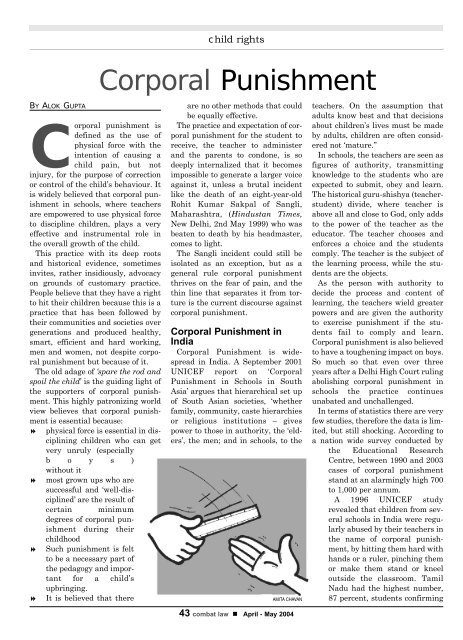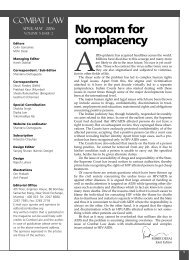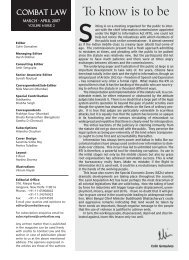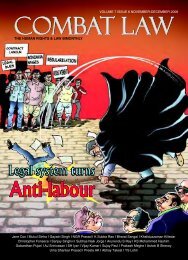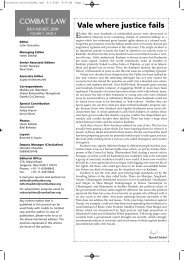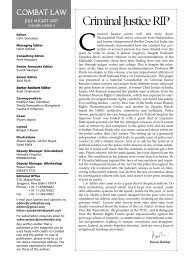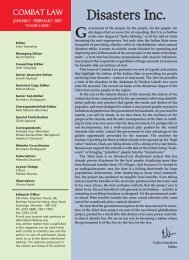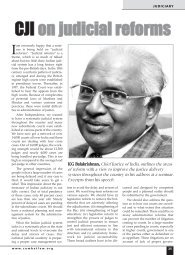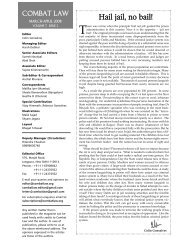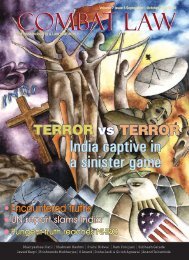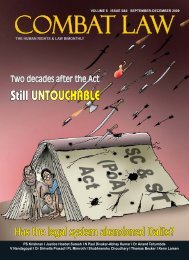PDF, 1.1MB - Combat Law
PDF, 1.1MB - Combat Law
PDF, 1.1MB - Combat Law
Create successful ePaper yourself
Turn your PDF publications into a flip-book with our unique Google optimized e-Paper software.
BY ALOK GUPTACorporal punishment isdefined as the use ofphysical force with theintention of causing achild pain, but notinjury, for the purpose of correctionor control of the child’s behaviour. Itis widely believed that corporal punishmentin schools, where teachersare empowered to use physical forceto discipline children, plays a veryeffective and instrumental role inthe overall growth of the child.This practice with its deep rootsand historical evidence, sometimesinvites, rather insidiously, advocacyon grounds of customary practice.People believe that they have a rightto hit their children because this is apractice that has been followed bytheir communities and societies overgenerations and produced healthy,smart, efficient and hard working,men and women, not despite corporalpunishment but because of it.The old adage of ‘spare the rod andspoil the child’ is the guiding light ofthe supporters of corporal punishment.This highly patronizing worldview believes that corporal punishmentis essential because: physical force is essential in discipliningchildren who can getvery unruly (especiallyb o y s )without it most grown ups who aresuccessful and ‘well-disciplined’are the result ofcertain minimumdegrees of corporal punishmentduring theirchildhood Such punishment is feltto be a necessary part ofthe pedagogy and importantfor a child’supbringing. It is believed that therechild rightsCorporal Punishmentare no other methods that couldbe equally effective.The practice and expectation of corporalpunishment for the student toreceive, the teacher to administerand the parents to condone, is sodeeply internalized that it becomesimpossible to generate a larger voiceagainst it, unless a brutal incidentlike the death of an eight-year-oldRohit Kumar Sakpal of Sangli,Maharashtra, (Hindustan Times,New Delhi, 2nd May 1999) who wasbeaten to death by his headmaster,comes to light.The Sangli incident could still beisolated as an exception, but as ageneral rule corporal punishmentthrives on the fear of pain, and thethin line that separates it from tortureis the current discourse againstcorporal punishment.Corporal Punishment inIndiaCorporal Punishment is widespreadin India. A September 2001UNICEF report on ‘CorporalPunishment in Schools in SouthAsia’ argues that hierarchical set upof South Asian societies, ‘whetherfamily, community, caste hierarchiesor religious institutions – givespower to those in authority, the ‘elders’,the men; and in schools, to theAMITA CHAVAN43 combat law • April - May 2004teachers. On the assumption thatadults know best and that decisionsabout children’s lives must be madeby adults, children are often considerednot ‘mature.’’In schools, the teachers are seen asfigures of authority, transmittingknowledge to the students who areexpected to submit, obey and learn.The historical guru-shishya (teacherstudent)divide, where teacher isabove all and close to God, only addsto the power of the teacher as theeducator. The teacher chooses andenforces a choice and the studentscomply. The teacher is the subject ofthe learning process, while the studentsare the objects.As the person with authority todecide the process and content oflearning, the teachers wield greaterpowers and are given the authorityto exercise punishment if the studentsfail to comply and learn.Corporal punishment is also believedto have a toughening impact on boys.So much so that even over threeyears after a Delhi High Court rulingabolishing corporal punishment inschools the practice continuesunabated and unchallenged.In terms of statistics there are veryfew studies, therefore the data is limited,but still shocking. According toa nation wide survey conducted bythe Educational ResearchCentre, between 1990 and 2003cases of corporal punishmentstand at an alarmingly high 700to 1,000 per annum.A 1996 UNICEF studyrevealed that children from severalschools in India were regularlyabused by their teachers inthe name of corporal punishment,by hitting them hard withhands or a ruler, pinching themor make them stand or kneeloutside the classroom. TamilNadu had the highest number,87 percent, students confirming


